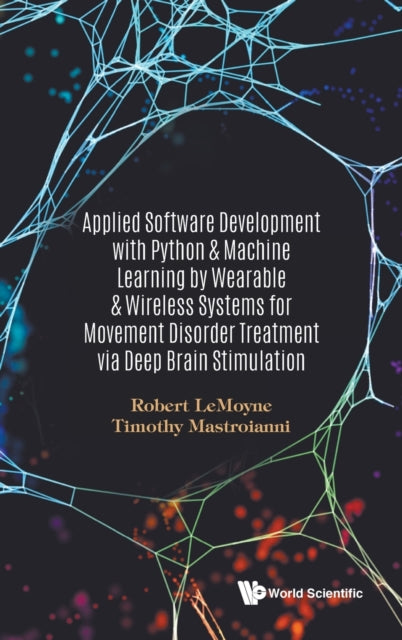RobertLemoyne,TimothyMastroianni
Applied Software Development With Python & Machine Learning By Wearable & Wireless Systems For Movement Disorder Treatment Via Deep Brain Stimulation
Applied Software Development With Python & Machine Learning By Wearable & Wireless Systems For Movement Disorder Treatment Via Deep Brain Stimulation
YOU SAVE £8.60
- Condition: Brand new
- UK Delivery times: Usually arrives within 2 - 3 working days
- UK Shipping: Fee starts at £2.39. Subject to product weight & dimension
Bulk ordering. Want 15 or more copies? Get a personalised quote and bigger discounts. Learn more about bulk orders.
Couldn't load pickup availability
- More about Applied Software Development With Python & Machine Learning By Wearable & Wireless Systems For Movement Disorder Treatment Via Deep Brain Stimulation
The book discusses the use of wearable and wireless inertial sensor systems, such as smartphones, for deep brain stimulation to treat movement disorders like essential tremor. It also highlights the role of machine learning in distinguishing between different deep brain stimulation settings. The book emphasizes the importance of organizing the software development process and developing software automation using Python for post-processing inertial sensor signal data. It provides a perspective on machine learning and evaluates various algorithms for essential tremor treatment. The skills acquired in software development and machine learning applications with wearable and wireless inertial sensor systems enable new and innovative biomedical research.
Format: Hardback
Length: 248 pages
Publication date: 29 July 2021
Publisher: World Scientific Publishing Co Pte Ltd
The book explores the integration of wearable and wireless inertial sensor systems, such as smartphones, for deep brain stimulation in the treatment of movement disorders like essential tremor. Machine learning plays a crucial role in this endeavor by distinguishing between different deep brain stimulation settings, such as "on" and "off" status. This breakthrough offers initial insights into the concept of Network Centric Therapy, which envisiones the Internet of Things for healthcare and the biomedical industry. It encompasses wearable and wireless inertial sensor systems, machine learning, and access to Cloud computing resources.
To achieve these objectives, the software development process is organized. Requirements and pseudo code are derived, and software automation using Python for post-processing inertial sensor signal data to a feature set for machine learning is progressively developed. A comprehensive perspective of machine learning is provided, encompassing its conceptual basis and operational overview. Subsequently, various machine learning algorithms are evaluated based on their ability to perform a reach and grasp task for essential tremor using a smartphone as a wearable and wireless accelerometer system.
These skills in software development and machine learning applications with wearable and wireless inertial sensor systems empower researchers to embark on innovative biomedical research, limited only by their imagination.
Here is the rephrased text:
The book delves into the convergence of wearable and wireless inertial sensor systems, including smartphones, for the application of deep brain stimulation in the treatment of movement disorders such as essential tremor. Machine learning assumes a pivotal role in this endeavor by facilitating the differentiation between distinct deep brain stimulation settings, such as "on" and "off" status. This groundbreaking achievement provides initial glimpses into the concept of Network Centric Therapy, an innovative vision that envisions the Internet of Things (IoT) as a transformative force in healthcare and the biomedical industry. It encompasses the integration of wearable and wireless inertial sensor systems, machine learning, and access to cloud computing resources.
To achieve these objectives, a meticulous software development process is meticulously orchestrated. Requirements and pseudo code are meticulously derived, paving the way for the progressive development of software automation utilizing Python for the post-processing of inertial sensor signal data, aimed at generating a feature set suitable for machine learning. A comprehensive perspective of machine learning is presented, encompassing its conceptual foundations and operational overview. Subsequently, various machine learning algorithms are assessed based on their ability to execute a reach and grasp task for essential tremor, utilizing a smartphone as a wearable and wireless accelerometer system.
These skills in software development and machine learning applications with wearable and wireless inertial sensor systems empower researchers to embark on groundbreaking biomedical research, unbounded by the limitations of imagination.
Weight: 514g
Dimension: 159 x 237 x 23 (mm)
ISBN-13: 9789811235955
This item can be found in:
UK and International shipping information
UK and International shipping information
UK Delivery and returns information:
- Delivery within 2 - 3 days when ordering in the UK.
- Shipping fee for UK customers from £2.39. Fully tracked shipping service available.
- Returns policy: Return within 30 days of receipt for full refund.
International deliveries:
Shulph Ink now ships to Australia, Belgium, Canada, France, Germany, Ireland, Italy, India, Luxembourg Saudi Arabia, Singapore, Spain, Netherlands, New Zealand, United Arab Emirates, United States of America.
- Delivery times: within 5 - 10 days for international orders.
- Shipping fee: charges vary for overseas orders. Only tracked services are available for most international orders. Some countries have untracked shipping options.
- Customs charges: If ordering to addresses outside the United Kingdom, you may or may not incur additional customs and duties fees during local delivery.


